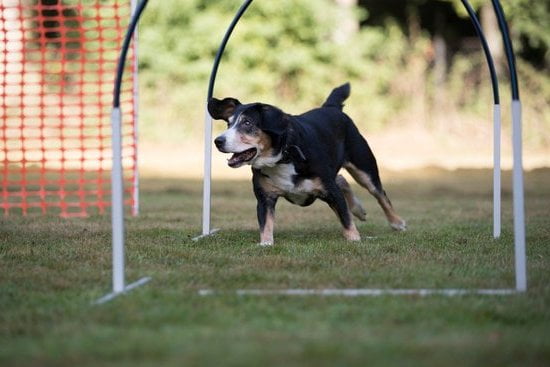Is your furry friend barking up a storm? If you’re wondering how to train a dog to not bark, you’re in the right place. Understanding the reasons behind your dog’s barking is the first step in addressing this behavior.
In this article, we’ll explore positive reinforcement training methods, consistency in training, identifying triggers, desensitization techniques, management strategies, seeking professional help, and staying committed to the process. By following these tips and tricks, you’ll be able to enjoy a quiet and well-behaved pup in no time.
Dogs bark for various reasons – to communicate, express excitement or anxiety, or even out of boredom. Before diving into training methods to stop excessive barking, it’s essential to understand why dogs bark in the first place. This understanding will allow you to tailor your approach to effectively address the root cause of the behavior.
Positive reinforcement training methods are at the core of teaching your dog not to bark excessively. By using rewards such as treats or praise to encourage quiet behavior and ignoring or redirecting unwanted barking, you can effectively communicate with your furry companion and shape their behavior in a positive way.
Consistency in training is key when it comes to changing your dog’s barking habits. Establishing a routine and sticking to it will help reinforce desired behaviors and discourage excessive vocalization.
Positive Reinforcement Training Methods
Dogs bark for a variety of reasons – it could be due to excitement, fear, boredom, or as a form of communication. Understanding the root cause of your dog’s barking is crucial in effectively training them to not bark excessively. Positive reinforcement training methods have been proven to be effective in teaching dogs new behaviors, including being quiet on command.
Using rewards such as treats, toys, or verbal praise can encourage your dog to exhibit calm and quiet behavior. When your dog refrains from barking in response to a trigger, immediately reward them with positive reinforcement. This will help your dog associate quiet behavior with positive outcomes, making them more likely to repeat the behavior in the future.
Consistency is key when using positive reinforcement as a training method. Establishing a consistent training routine and ensuring that all family members are on board with the training process is important. This means always rewarding quiet behavior and never inadvertently reinforcing barking by giving in to their demands. Remember that each dog is unique and may respond differently to various rewards, so it may take some trial and error to determine what motivates your specific dog.
Understanding what triggers your dog’s barking is essential in addressing the behavior. Whether it’s the doorbell ringing, seeing other dogs through the window, or loud noises outside, identifying these triggers can help you anticipate when your dog might bark and proactively redirect their attention before they start barking. Not only will this reduce their overall barking, but it will also create an opportunity for you to positively reinforce their silence.
| Positive Reinforcement Training Methods: Using Rewards | To Encourage Quiet Behavior |
|---|---|
| Dogs respond well to positive reinforcement | Rewards can include treats, toys, and verbal praise |
| Consistency is key in this training method | All family members should be on board with the process |
| Identifying triggers helps proactively address barking behavior | This helps anticipate when the dog might bark and redirect their attention |
Consistency Is Key
Training a dog to not bark requires a consistent and structured training routine. Dogs thrive on routine and predictability, so it’s important to establish a set schedule for training sessions. Here are some tips on how to train a dog to not bark through consistency:
1. Set specific times for training: Determine the best times of day to work with your dog on barking behavior. Whether it’s first thing in the morning, after meal times, or in the evening, consistency in timing will help your dog understand when to expect training.
2. Use consistent commands: When teaching your dog to be quiet, use the same command every time they bark. Whether it’s “quiet” or “enough,” using a consistent command will help your dog associate the word with the desired behavior.
3. Stick to a routine: Dogs respond well to routines, so try to keep all other aspects of their daily life as consistent as possible. This includes feeding times, walking schedules, and playtime. By maintaining consistency in all areas of their life, you can create an environment where your dog feels secure and understands what is expected of them.
By establishing a consistent training routine with these tips, you can effectively teach your dog to not bark in certain situations. Remember that patience and persistence are key when it comes to modifying your dog’s behavior, so stay committed to the process and celebrate small victories along the way.
Identifying Triggers
Understanding what triggers your dog’s barking is an essential step in effectively training them to be quiet. Dogs bark for a variety of reasons, including to alert you of something, to communicate with other dogs, out of fear or anxiety, or simply out of boredom. By identifying the specific triggers that cause your dog to bark, you can better address the root cause of their behavior and tailor your training approach accordingly.
To identify your dog’s triggers, keep a journal or log of when and where your dog barks. Note the time of day, the presence of certain people or animals, the environment they are in, and any other relevant factors. This will help you pinpoint patterns and common denominators that contribute to their barking behavior. Additionally, observe your dog’s body language and vocalizations when they bark to better understand their emotional state and motivations.
Once you have a better understanding of what makes your dog bark, you can begin implementing desensitization techniques to gradually expose them to their triggers in a controlled manner. This may involve creating positive associations with previously fear-inducing stimuli through counter-conditioning and systematic desensitization. By slowly introducing triggers at a manageable intensity level while using positive reinforcement, you can help reduce your dog’s reactivity over time.
It is important to remember that every dog is unique, so what triggers one dog may not affect another in the same way. Patience and attentiveness are crucial when identifying triggers and modifying your training methods accordingly. With consistency and dedication, you can help your dog learn to remain calm and quiet in various situations.
Desensitization Techniques
The key to desensitization is to start with a very low level of the trigger and slowly increase exposure as your dog becomes more comfortable. For example, if your dog barks at other dogs, you may start by having them observe other dogs from a distance where they do not react.
Gradually, you can decrease the distance between your dog and the other dogs as long as they remain calm and quiet. This process requires patience and consistency, but it can be highly effective in reducing excessive barking behavior.
When using desensitization techniques, it’s important to always end each session on a positive note. This means that your dog should be rewarded for remaining calm and not barking in response to the trigger. Over time, this will help your dog associate the trigger with positive outcomes, ultimately helping them learn not to bark in those situations. With dedication and persistence, desensitization can be an effective method for training a dog to not bark excessively.
By integrating desensitization techniques into your training routine, you can help your dog overcome their urge to bark in response to various triggers. Remember that every dog is unique, so it’s essential to tailor your approach to suit their specific needs and behaviors. With time and effort, you can successfully teach your furry companion how to remain calm and quiet in various situations.
Management Strategies
Bark Collars
Bark collars are a common tool used to discourage excessive barking in dogs. There are different types of bark collars, including citronella bark collars, ultrasonic bark collars, and static bark collars. These collars work by delivering a mild punishment or deterrent each time the dog barks excessively.
It is crucial to choose the right type of bark collar that is suitable for your dog’s size and temperament. When using a bark collar, it is essential to follow the manufacturer’s instructions and ensure that it is used in conjunction with positive reinforcement training methods.
Sound Machines
Sound machines can also be effective in reducing a dog’s barking behavior. These devices emit high-pitched or ultrasonic sounds that are unpleasant to dogs when they bark. The idea is that the sound will deter the dog from barking excessively without causing them any harm. Sound machines can be particularly useful in outdoor settings or areas where it may be challenging to use other training methods consistently.
Combining Tools With Training
While management tools such as bark collars and sound machines can be helpful in curbing excessive barking, it is important to remember that these should be used as part of a comprehensive training plan. Implementing positive reinforcement training methods alongside the use of management tools can help reinforce quiet behavior while addressing the underlying reasons for the dog’s barking.
Additionally, consulting with a professional dog trainer or behaviorist can provide guidance on how to integrate these tools seamlessly into an effective training regimen.
Seeking Professional Help
Dogs are known for barking as a way of communicating, but excessive barking can be a nuisance. If you have tried positive reinforcement methods and consistency in training your dog to not bark with little success, it may be time to seek professional help from a dog trainer or behaviorist. These professionals can provide guidance and expertise on how to address your dog’s excessive barking and develop a tailored training plan.
A dog trainer or behaviorist can assess your dog’s behavior and identify any underlying issues that may be contributing to the excessive barking. They will work with you to understand the triggers for your dog’s barking and develop a customized training program to address the behavior. By working with a professional, you can gain valuable insight into your dog’s behavior and learn effective techniques for managing their barking.
When considering hiring a dog trainer or behaviorist, it is important to choose someone who is experienced and certified in canine behavior. Look for recommendations from other pet owners, read reviews, and schedule consultations with potential professionals to discuss your concerns about your dog’s barking. A qualified trainer or behaviorist will have the knowledge and skills to guide you through the training process effectively.
By seeking professional help, you can benefit from expert guidance on how to train a dog to not bark excessively. With their support, you can develop a comprehensive training plan that addresses the root cause of the barking and helps your dog learn alternative behaviors. Additionally, working with a professional can provide reassurance and encouragement as you navigate the training process.
| Professional Help | Hiring Criteria |
|---|---|
| Assessment of Dog Behavior | Experience and Certification |
| Customized Training Program | Recommendations and Reviews |
| Expert Guidance | Reassurance and Encouragement |
Patience and Persistence
Training a dog to not bark can be a challenging and time-consuming process, but with patience and persistence, it is achievable. Here are some tips for staying committed to the training process.
Set Realistic Expectations
It’s important to understand that training a dog to not bark will not happen overnight. It requires time, effort, and consistency. Setting realistic expectations for the training process will help you stay motivated and focused on the end goal.
Stay Consistent
Consistency is key when it comes to training a dog. Make sure that everyone in the household is on board with the training methods and consistently enforces them. This will prevent confusion for your dog and ensure that they understand what behavior is expected of them.
Seek Support
Don’t be afraid to seek support from fellow dog owners, trainers, or behaviorists. Joining a community of people who are also working on training their dogs can provide valuable insight and encouragement. Additionally, seeking professional help when needed can make a world of difference in the training process.
By staying patient and persistent, you can effectively train your dog to not bark excessively and enjoy a quieter, more peaceful living environment for both you and your pet. With dedication and the right techniques, it is certainly possible to achieve success in this aspect of dog training.
Celebrating Success
In conclusion, training a dog to not bark requires understanding the reasons behind their barking behavior, implementing positive reinforcement techniques, and being consistent in your training routine. It’s important to identify what triggers your dog’s barking and gradually expose them to these triggers in a controlled environment using desensitization techniques. Additionally, management strategies such as bark collars or sound machines can be used as tools in the training process.
If you find yourself struggling, seeking professional help from a dog trainer or behaviorist may be necessary. Throughout the entire training process, patience and persistence are key factors in achieving success.
Recognizing and rewarding your dog’s progress is an essential part of the training process. When your dog exhibits quiet behavior instead of barking, be sure to celebrate it with praise and rewards. This positive reinforcement will reinforce the desired behavior and encourage your dog to continue practicing it. Whether it’s through verbal praise, treats, or toys, finding what motivates your dog is crucial in celebrating their success.
It’s important to remember that every dog is different, and some may respond more quickly to training while others may take more time. Regardless of the pace at which progress is made, staying committed to the training process and remaining patient will ultimately lead to success in teaching your dog to not bark excessively.
Frequently Asked Questions
How Do I Get My Dog to Stop Barking at Everything?
Getting your dog to stop barking at everything requires understanding the root cause of their behavior. It may be due to boredom, anxiety, territorial instincts, or simply seeking attention. Addressing these underlying issues through exercise, training, and positive reinforcement can help reduce excessive barking.
How Do I Tell My Dog Not to Bark?
When telling your dog not to bark, it’s important to remain calm and avoid shouting as this may reinforce the behavior. Use a firm but gentle tone to command “quiet” or “enough,” and wait for a brief moment of silence before rewarding them with treats or praise. Consistency is key in reinforcing this command.
How Do I Teach My Dog the Quiet Command?
Teaching your dog the quiet command involves catching them in the act of barking and using a verbal cue such as “quiet” followed by a hand signal like placing your finger on your lips. Once they stop barking, reward them with treats and gradually introduce the quiet command in various situations until they understand its meaning.
Consistent practice and positive reinforcement will help them learn to stay quiet on command.

Welcome to the blog! I am a professional dog trainer and have been working with dogs for many years. In this blog, I will be discussing various topics related to dog training, including tips, tricks, and advice. I hope you find this information helpful and informative. Thanks for reading!





